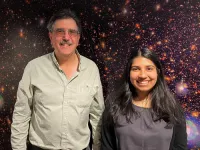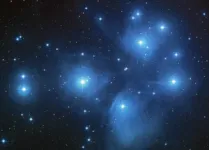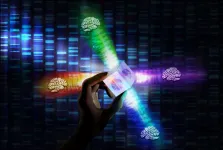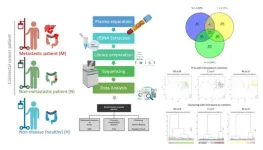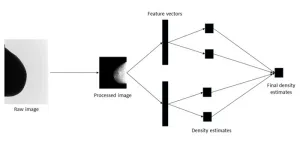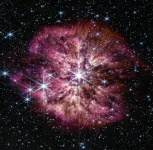(Press-News.org) It feels like a classical paradox: How do you see the invisible? But for modern astronomers, it is a very real challenge: How do you measure dark matter, which by definition emits no light?
The answer: You see how it impacts things that you can see. In the case of dark matter, astronomers watch how light from distant galaxies bends around it.
An international team of astrophysicists and cosmologists have spent the past year teasing out the secrets of this elusive material, using sophisticated computer simulations and the observations from the one of the most powerful astronomical cameras in the world, the Hyper Suprime-Cam (HSC). The team is led by astronomers from Princeton University and the astronomical communities of Japan and Taiwan, using data from the first three years of the HSC sky survey, a wide-field imaging survey carried out with the 8.2-meter Subaru telescope on the summit of Maunakea in Hawai’i. Subaru is operated by the National Astronomical Observatory of Japan; its name is the Japanese word for the cluster of stars we call the Pleiades.
The team presented their findings at a webinar attended by more than 200 people, and they will share their work at the "Future Science with CMB x LSS" conference in Japan.
“Our overall goal is to measure some of the most fundamental properties of our universe,” said Roohi Dalal, a graduate student in astrophysics at Princeton. “We know that dark energy and dark matter make up 95% of our universe, but we understand very little about what they actually are and how they’ve evolved over the history of the universe. Clumps of dark matter distort the light of distant galaxies through weak gravitational lensing, a phenomenon predicted by Einstein’s General Theory of Relativity. This distortion is a really, really small effect; the shape of a single galaxy is distorted by an imperceptible amount. But when we make that measurement for 25 million galaxies, we’re able to measure the distortion with quite high precision.”
To jump to the punchline: The team has measured a value for the “clumpiness” of the universe’s dark matter (known to cosmologists as “S8”) of 0.776, which aligns with values that other gravitational lensing surveys have found in looking at the relatively recent universe — but it does not align with the value of 0.83 derived from the Cosmic Microwave Background, which dates back to the universe’s origins.
The gap between these two values is small, but as more and more studies confirm each of the two values, it doesn’t appear to be accidental. The other possibilities are that there’s some as-yet unrecognized error or mistake in one of these two measurements or the standard cosmological model is incomplete in some interesting way.
“We’re still being fairly cautious here,” said Michael Strauss, chair of Princeton’s Department of Astrophysical Sciences and one of the leaders of the HSC team. “We’re not saying that we’ve just discovered that modern cosmology is all wrong, because, as Roohi has emphasized, the effect that we’re measuring is a very subtle one. Now, we think we’ve done the measurement right. And the statistics show that there’s only a one in 20 chance that it’s just due to chance, which is compelling but not completely definitive. But as we in the astronomy community come to the same conclusion over multiple experiments, as we keep on doing these measurements, perhaps we’re finding that it’s real.”
Hiding and uncovering the data
The idea that some change is needed in the standard cosmological model, that there is some fundamental piece of cosmology yet to be discovered, is a deliciously enticing one for some scientists.
“We are human beings, and we do have preferences. That’s why we do what we call a ‘blinded’ analysis,” Strauss said. “Scientists have become self-aware enough to know that we will bias ourselves, no matter how careful we are, unless we carry out our analysis without allowing ourselves to know the results until the end. For me, I would love to really find something fundamentally new. That would be truly exciting. But because I am prejudiced in that direction, we want to be very careful not to let that influence any analysis that we do.”
To protect their work from their biases, they quite literally hid their results from themselves and their colleagues — month after month after month.
“I worked on this analysis for a year and didn’t get to see the values that were coming out,” said Dalal.
The team even added an extra obfuscating layer: they ran their analyses on three different galaxy catalogs, one real and two with numerical values offset by random values.
“We didn’t know which of them was real, so even if someone did accidentally see the values, we wouldn’t know if the results were based on the real catalog or not,” she said.
On February 16, the international team gathered together on Zoom — in the evening in Princeton, in the morning in Japan and Taiwan — for the “unblinding.”
“It felt like a ceremony, a ritual, that we went through,” Strauss said. “We unveiled the data, and ran our plots, immediately we saw it was great. Everyone went, ‘Oh, whew!’ and everyone was very happy.”
Dalal and her roommate popped a bottle of champagne that night.
A huge survey with the world’s largest telescope camera
HSC is the largest camera on a telescope of its size in the world, a mantle it will hold until the Vera C. Rubin Observatory currently under construction in the Chilean Andes, begins the Legacy Survey of Space and Time (LSST) in late 2024. In fact, the raw data from HSC is processed with the software designed for LSST. “It is fascinating to see that our software pipelines are able to handle such large quantities of data well ahead of LSST,” said Andrés Plazas, an associate research scholar at Princeton.
The survey that the research team used covers about 420 square degrees of the sky, about the equivalent of 2000 full moons. It’s not a single contiguous chunk of sky, but split among six different pieces, each about the size that you could cover with an outstretched fist. The 25 million galaxies they surveyed are so distant that instead of seeing these galaxies as they are today, the HSC recorded how they were billions of years ago.
Each of these galaxies glows with the fires of tens of billions of suns, but because they are so far away, they are extremely faint, as much as 25 million times fainter than the faintest stars we can see with the naked eye.
“It is extremely exciting to see these results from HSC collaboration, especially as this data is closest to what we expect from Rubin Observatory, which the community is working towards together,” said cosmologist Alexandra Amon, a Senior Kavli Fellow at Cambridge University and a senior researcher at Trinity College, who was not involved in this research. “Their deep survey makes for beautiful data. For me, it is intriguing that HSC, like the other independent weak lensing surveys, point to a low value for S8 — it’s important validation, and exciting that these tensions and trends force us to pause and think about what that data is telling us about our Universe!”
The standard cosmological model
The standard model of cosmology is “astonishingly simple” in some ways, explained Andrina Nicola of the University of Bonn, who advised Dalal on this project when she was a postdoctoral scholar at Princeton. The model posits that the universe is made up of only four basic constituents: ordinary matter (atoms, mostly hydrogen and helium), dark matter, dark energy and photons.
According to the standard model, the universe has been expanding since the Big Bang 13.8 billion years ago: it started out almost perfectly smooth, but the pull of gravity on the subtle fluctuations in the universe has caused structure — galaxies enveloped in dark matter clumps — to form. In the present-day universe, the relative contributions of ordinary matter, dark matter, dark energy are about 5%, 25% and 70%, plus a tiny contribution from photons.
The standard model is defined by only a handful of numbers: the expansion rate of the universe; a measure of how clumpy the dark matter is (S8); the relative contributions of the constituents of the universe (the 5%, 25%, 70% numbers above); the overall density of the universe; and a technical quantity describing how the clumpiness of the universe on large scales relates to that on small scales.
“And that’s basically it!” Strauss said. “We, the cosmological community, have converged on this model, which has been in place since the early 2000s.”
Cosmologists are eager to test this model by constraining these numbers in various ways, such as by observing the fluctuations in the Cosmic Microwave Background (which in essence is the universe’s baby picture, capturing how it looked after its first 400,000 years), modeling the expansion history of the universe, measuring the clumpiness of the universe in the relatively recent past, and others.
“We’re confirming a growing sense in the community that there is a real discrepancy between the measurement of clumping in the early universe (measured from the CMB) and that from the era of galaxies, ‘only’ 9 billion years ago,” said Arun Kannawadi, an associate research scholar at Princeton who was involved in the analysis.
Five lines of attack
Dalal’s work does a so-called Fourier-space analysis; a parallel real-space analysis was led by Xiangchong Li of Carnegie Mellon University, who worked in close collaboration with Rachel Mandelbaum, who completed her physics A.B. in 2000 and her Ph.D. in 2006, both from Princeton. A third analysis, a so-called 3x2-point analysis, takes a different approach of measuring the gravitational lensing signal around individual galaxies, to calibrate the amount of dark matter associated with each galaxy. That analysis was led by Sunao Sugiyama of the University of Tokyo, Hironao Miyatake (a former Princeton postdoctoral fellow) of Nagoya University and Surhud More of the Inter-University Centre for Astronomy and Astrophysics in Pune, India.
These five sets of analyses each use the HSC data to come to the same conclusion about S8.
Doing both the real-space analysis and the Fourier-space analysis “was sort of a sanity check,” said Dalal. She and Li worked closely to coordinate their analyses, using blinded data. Any discrepancies between those two would say that the researchers’ methodology was wrong. “It would tell us less about astrophysics and more about how we might have screwed up,” Dalal said.
“We didn’t know until the unblinding that two results were bang-on identical,” she said. “It felt miraculous.”
Sunao added: “Our 3x2-point analysis combines the weak lensing analysis with the clustering of galaxies. Only after unblinding did we know that our results were in beautiful agreement with those of Roohi and Xiangchong. The fact that all these analyses are giving the same answer gives us confidence that we’re doing something right!”
Learn more at https://hsc-release.mtk.nao.ac.jp/doc/index.php/. This research will be presented at "Future Science with CMB x LSS," a conference running from April 10-14 at Yukawa Institute for Theoretical Physics, Kyoto University. This research was supported by the National Science Foundation Graduate Research Fellowship Program (DGE-2039656); the National Astronomical Observatory of Japan; the Kavli Institute for the Physics and Mathematics of the Universe; the University of Tokyo; the High Energy Accelerator Research Organization (KEK); the Academia Sinica Institute for Astronomy and Astrophysics in Taiwan; Princeton University; the FIRST program from the Japanese Cabinet Office; the Ministry of Education, Culture, Sports, Science and Technology (MEXT); the Japan Society for the Promotion of Science; the Japan Science and Technology Agency; the Toray Science Foundation; and the Vera C. Rubin Observatory.
END
How to see the invisible: Using the dark matter distribution to test our cosmological model
A Princeton-led team of astrophysicists has measured a value for the “clumpiness” of the universe’s dark matter that suggests the standard cosmological model might need to be revised
2023-04-07
ELSE PRESS RELEASES FROM THIS DATE:
Four different autism subtypes identified in brain study
2023-04-07
People with autism spectrum disorder can be classified into four distinct subtypes based on their brain activity and behavior, according to a study from Weill Cornell Medicine investigators.
The study, published March 9 in Nature Neuroscience, leveraged machine learning to analyze newly available neuroimaging data from 299 people with autism and 907 neurotypical people. They found patterns of brain connections linked with behavioral traits in people with autism, such as verbal ability, social affect, and repetitive or stereotypic behaviors. They confirmed that the four autism subgroups could also be replicated in a separate dataset ...
New method of clustering colorectal cancer patients using DPE sequencing
2023-04-07
“[...] DPE analysis may have an important role in improving the diagnosis and management of CRC.”
BUFFALO, NY- April 7, 2023 – A new editorial paper was published in Oncoscience (Volume 10) on March 23, 2023, entitled, “New method of clustering colorectal cancer patients using differential presence of exons (DPE) sequencing.”
Colorectal cancer (CRC) is a heterogeneous disease that occurs in the colon and the rectum, parts of the gastrointestinal system. CRC is the third leading cause of cancer-related ...
Deep learning model estimates cancer risk from breast density
2023-04-07
Breast cancer is the most common cancer to affect women worldwide. According to the American Cancer Society, about 1 in 8 women in the United States will develop breast cancer in their lifetime. While it is not possible to entirely prevent breast cancer, various medical organizations advise regular screening to detect and treat cases at the early stage. The breast density, defined as the proportion of fibro-glandular tissue within the breast, is often used to assess the risk of developing breast cancer. While various methods are available to estimate this measure, studies have shown that subjective assessments conducted by radiologists based on visual analogue scales ...
COVID-19 pandemic increased the frequency of intimate partner violence
2023-04-07
Lesbian, gay, bisexual, transgender and queer people who experienced intimate partner violence in their current relationship before COVID-19 had an increase in the frequency of victimization after the pandemic began, according to a Rutgers study.
While national emergencies, crises and pandemics increase the frequency of health risks and intimate partner violence few studies have considered the nuances of social and psychological factors, such as socioeconomic characteristics and mental health, in explaining the increase in intimate partner violence during times of crisis.
“To date, most programs on intimate ...
Scientists discover a way Earth’s atmosphere cleans itself
2023-04-07
Irvine, Calif., April 7, 2023 — Human activities emit many kinds of pollutants into the air, and without a molecule called hydroxide (OH), many of these pollutants would keep aggregating in the atmosphere.
How OH itself forms in the atmosphere was viewed as a complete story, but in new research published in Proceedings of the National Academy of Sciences, a research team that includes Sergey Nizkorodov, a University of California, Irvine professor of chemistry, report that a strong electric field that exists at the surface between airborne water droplets and ...
Webb reveals never-before-seen details in Cassiopeia A
2023-04-07
The explosion of a star is a dramatic event, but the remains the star leaves behind can be even more dramatic. A new mid-infrared image from NASA’s James Webb Space Telescope provides one stunning example. It shows the supernova remnant Cassiopeia A (Cas A), created by a stellar explosion seen from Earth 340 years ago. Cas A is the youngest known remnant from an exploding, massive star in our galaxy, which makes it a unique opportunity to learn more about how such supernovae occur.
“Cas ...
A new quantum approach to solve electronic structures of complex materials
2023-04-07
If you know the atoms that compose a particular molecule or solid material, the interactions between those atoms can be determined computationally, by solving quantum mechanical equations — at least, if the molecule is small and simple. However, solving these equations, critical for fields from materials engineering to drug design, requires a prohibitively long computational time for complex molecules and materials.
Now, researchers at the U.S. Department of Energy’s (DOE) Argonne National Laboratory and the University of Chicago’s ...
The social framework
2023-04-07
On January 6, 2021, the public watched in disbelief as the Capitol building was stormed by hundreds of protestors. Most spectators at home didn't know violence at the Capitol building was already circulating through far-right social media channels for months.
Social media, for better or worse, play a large role in how we consume information – as well as spreading misinformation and conspiratorial propaganda.
Researchers at the University of Pittsburgh received $100,000 as part of the Meta Foundational Integrity Research ...
HonorHealth Research Institute joins City of Hope and TGen in creating method for scoring pancreatic cancer patients for surgery
2023-04-07
SCOTTSDALE, Ariz. — April 7, 2023 — A trio of premier Southwest biomedical research centers — HonorHealth Research Institute, City of Hope and the Translational Genomics Research Institute (TGen), part of City of Hope — have developed a more precise method that may help determine when it is best to surgically remove of pancreatic cancer tumors.
Surgical removal of the tumor can be a key step in helping extend the survival of patients with pancreatic cancer, one of the most aggressive and deadly of all malignancies and the nation’s third leading cause of cancer-related death. Currently, surgery — or surgery plus chemotherapy ...
CHOP-led study identifies two different regulatory T cell populations
2023-04-07
Philadelphia, April 7, 2022—A regulatory class of human T cells descends from two different origins, one that relates to autoimmunity and one that relates to protective immunity, according to a new study led by Children’s Hospital of Philadelphia (CHOP). The findings, published today in Science Immunology, could pave the way for new treatments for autoimmune diseases that target the immune system selectively.
“When it comes to autoimmunity, the prevailing wisdom has been that the only way to stop inflammation ...
LAST 30 PRESS RELEASES:
The Ceramic Society of Japan’s Oxoate Ceramics Research Association launches new international book project
Heart-brain connection: international study reveals the role of the vagus nerve in keeping the heart young
Researchers identify Rb1 as a predictive biomarker for a new therapeutic strategy in some breast cancers
Survey reveals ethical gaps slowing AI adoption in pediatric surgery
Stimulant ADHD medications work differently than thought
AI overestimates how smart people are, according to HSE economists
HSE researchers create genome-wide map of quadruplexes
Scientists boost cell "powerhouses" to burn more calories
Automatic label checking: The missing step in making reliable medical AI
Low daily alcohol intake linked to 50% heightened mouth cancer risk in India
American Meteorological Society announces Rick Spinrad as 2026 President-Elect
Biomass-based carbon capture spotlighted in newly released global climate webinar recording
Illuminating invisible nano pollutants: advanced bioimaging tracks the full journey of emerging nanoscale contaminants in living systems
How does age affect recovery from spinal cord injury?
Novel AI tool offers prognosis for patients with head and neck cancer
Fathers’ microplastic exposure tied to their children’s metabolic problems
Research validates laboratory model for studying high-grade serous ovarian cancer
SIR 2026 delivers transformative breakthroughs in minimally invasive medicine to improve patient care
Stem Cell Reports most downloaded papers of 2025 highlight the breadth and impact of stem cell research
Oxford-led study estimates NHS spends around 3% of its primary and secondary care budget on the health impacts of heat and cold in England
A researcher’s long quest leads to a smart composite breakthrough
Urban wild bees act as “microbial sensors” of city health.
New study finds where you live affects recovery after a hip fracture
Forecasting the impact of fully automated vehicle adoption on US road traffic injuries
Alcohol-related hospitalizations from 2016 to 2022
Semaglutide and hospitalizations in patients with obesity and established cardiovascular disease
Researchers ‘listen in’ to embryo-mother interactions during implantation using a culture system replicating the womb lining
How changing your diet could help save the world
How to make AI truly scalable and reliable for real-time traffic assignment?
Beyond fragmented markets: A new framework for efficient and stable ride-pooling
[Press-News.org] How to see the invisible: Using the dark matter distribution to test our cosmological modelA Princeton-led team of astrophysicists has measured a value for the “clumpiness” of the universe’s dark matter that suggests the standard cosmological model might need to be revised
